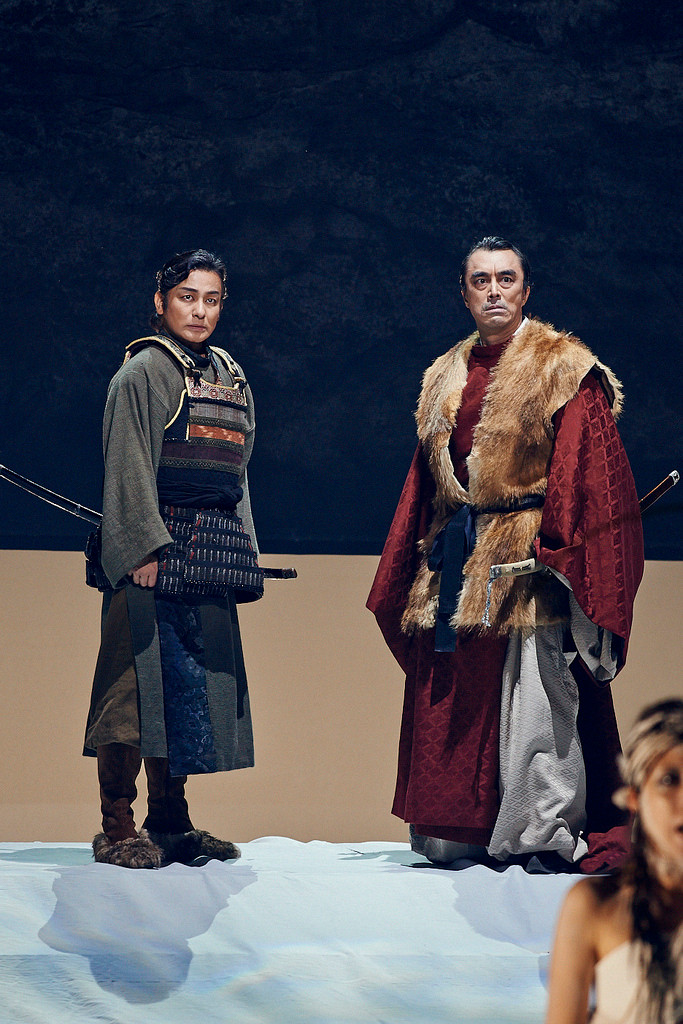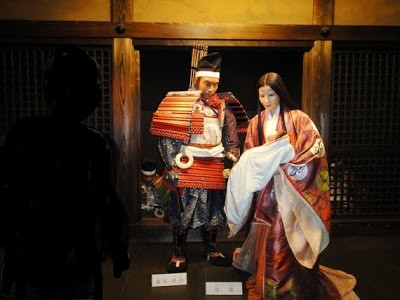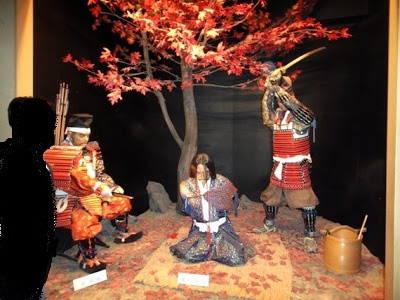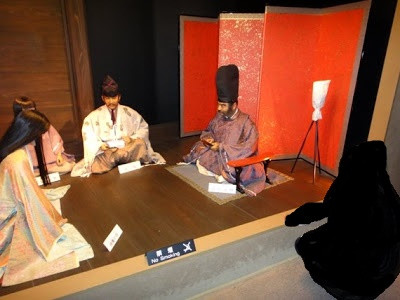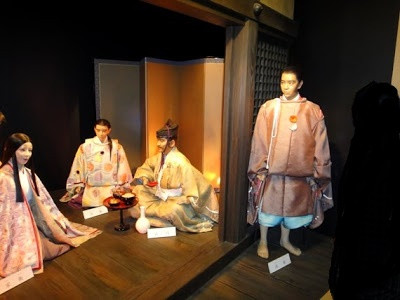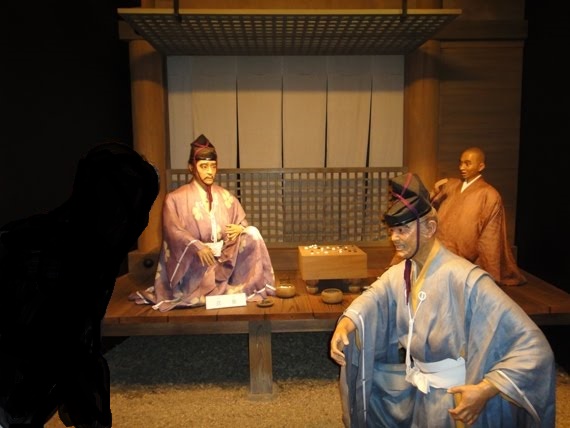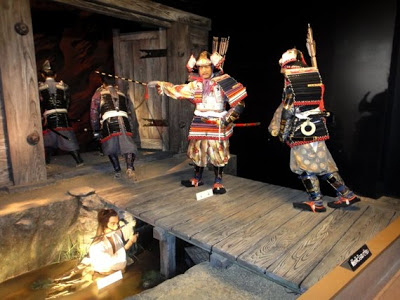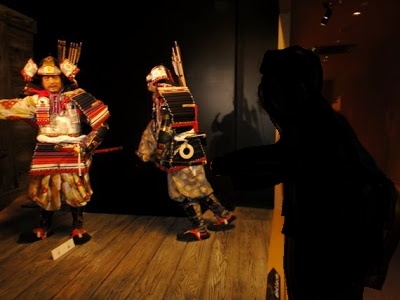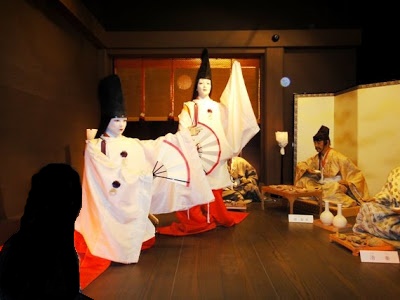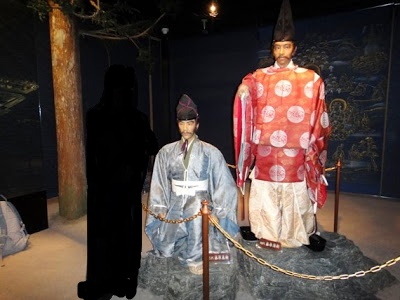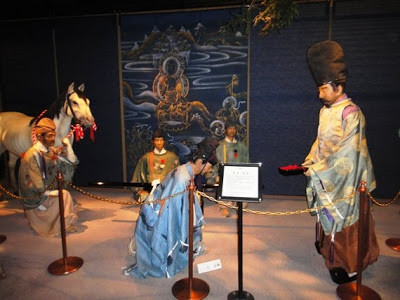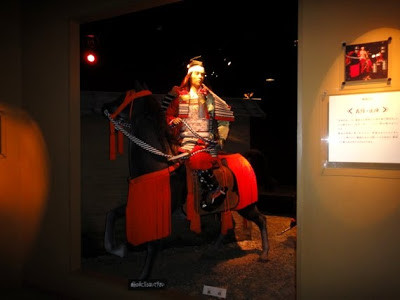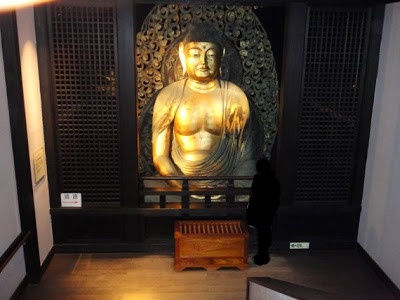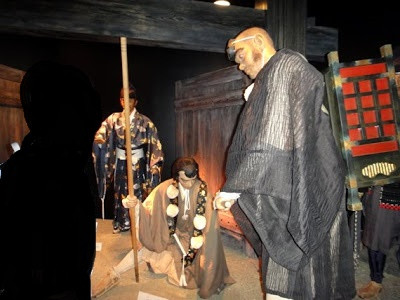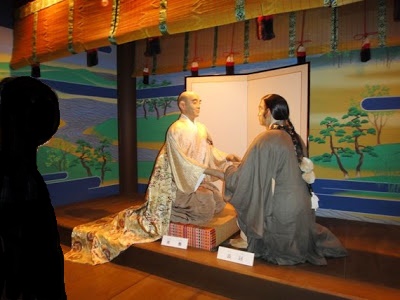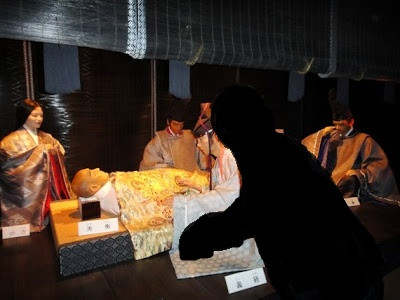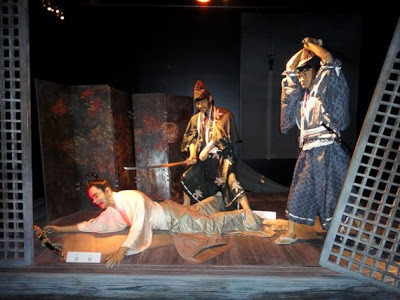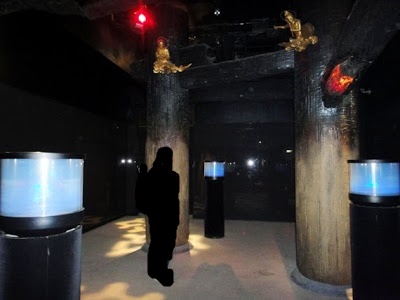HISTORY OF GAIL’S CATHERINE THE GREAT ANCESTORS (OSHU FUJIWARA FAMILY – CHILDREN OF VLADIMIR THE GREAT OF RUSSIA)
The following is a post about a visit to a wax museum in Japan about Gail’s ancestors. The images referred to in the post can be viewed in the following video:
Gail’s ancestors the Oshu Fujiwara, especially Fujiwara Yasuhira, were devout Buddhists who did not believe in war. This cost my ancestors their kingdom because they had no defenses when Minamoto Yoritomo attacked their headquarters and brought down the Oshu Fujiwara, whose children escaped and ended up intermarrying with the Emishi in hiding and creating the Ainu clan from which Gail is descended. This explains why Gail does not look Japanese even though her mother is Japanese (with Ainu blood from the Oshu Fujiwara) and speaks Japanese fluently. Nobody really knows where the Ainu came from, but it appears they are the Emishi children who intermarried with the Russian royals [CHECK OUT “THE FIRE STILL BURNS” OR HOMURA TATSU WITH ENGLISH SUBTITLES (Tsunekiyo Fujiwara 1, Tsunekiyo Fujiwara 2, Tsunekiyo Fujiwara 3, Tsunekiyo Fujiwara 4, Tsunekiyo Fujiwara 5, Tsunekiyo Fujiwara 6; Tsunekiyo Fujiwara 7)] who became the Oshu Fujiwara, whose kingdom was defeated and who then escaped into the Emishi clan (from which they came originally) and the children of the Emishi and Oshu Fujiwara became the Ainu. MY PATREON SUPPORTERS have access to the page with the entire Oshu Fujiwara mini-series (see Tsunekiyo Fujiwara above) with English subtitles. By the way, I am part of the team that put the English subtitles on this series because these are my ancestors.
So the Ainu appear to be royals in hiding who hid in the mountains and lived off the land and strangely adopted a lot of Russian folklore into their culture, like bear worship. That’s because they were really Russian royals in hiding or the progeny of Vladimir the Great of Russia (who came from the same gene pool that would produce Catherine the Great). You see, after the death of Vladimir the Great, there was intrigue inside of his court for succession and some of his many children had to escape Russia to stay alive. This is where Gail gets her Catherine the Great genes. Because history is rewritten by the victors, very few know the truth about the Ainu and their Russian royal ancestry from Vladimir the Great of Russia. Ironically, both Vladimir the Great’s progeny and the last Oshu Fujiwara leader (Fujiwara Yasuhira) renounced their thrones in order to avoid war (out of moral conviction against war). But because they were the leaders of their land, their opposition had them killed any ways and rewrote history to make their murders seem justified. Gail, like her ancestors, honors her moral convictions, even at the price of power and prestige. In many ways, Gail is like her ancestor Fujiwara Yasuhira, devoted to her moral code, even surrendering opportunities for power and wealth to do so, and willing to take on scorn (labelled as crazy) for opposing the war-loving Deep State (Loree McBride and her supporters). However, Gail is very much like King David (another of her ancestors), too, and is waging war against power-hungry Loree McBride and her evil Jesuits in order to ensure Satan’s kingdom does not prosper while Gail is alive.
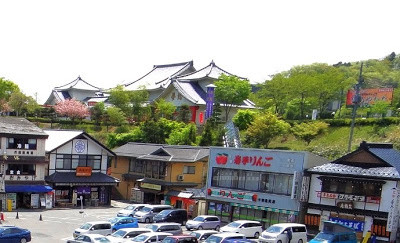
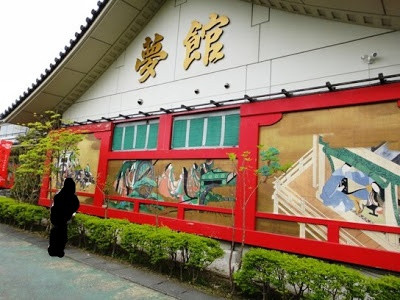
We visited Chusonji Temple Complex in Hiraizumi town of Iwate prefecture. We finished visiting most of the important halls and temples by 1.30 pm. After having lunch at a restaurant located within the temple precinct, we walked back to the Underpass Entrance of the temple complex. In an open area at the bottom of Chusonji’s main approach, we saw a small space fenced with bamboo. In the center stands a giant pine tree. At its base is a small stupa said to mark the grave of Musashibo Benkei, the faithful retainer of Yoshitsune Minamoto. A relatively new tombstone is placed near the grave.
After seeing the grave of Benkei, we walked back towards the car parking area. While walking we saw a traditional looking building on the top of a hill beside the car parking area. We enquired about the building and came to know that it is a museum named Yumeyakata Oshu-Fujiwara Rekishimonogatari. The design of the museum building is similar to Muryokoin Temple, which was a twelfth century temple and has perished long ago. Hiraizumi was once the center of the Oshu-Fujiwara clan that ruled the Tohoku Region from the 12th to the 13th centuries. The historical tales of the family as well as Yoshitsune Minamoto can be learned at Yumeyakata (Dream Residence) Museum. From the Earlier Nine Years War (1051-1062) to the burning of Hiraizumi, 30 famous scenes depicting the history and culture of Oshu-Fujiwara family’s rule are displayed with 107 life sized wax dolls. We bought tickets worth 1050 Yen per person as admission fee for the museum. As soon as we entered the museum, we were transported to a different world altogether. Images of the past came to life with spectacular holograms, sound effects, and lights.
Kiyohira Fujiwara was born in the Fujiwara family in the middle of Zen-kunen-no-eki (9 Years War). He led a severe tough life. He was the sole survivor of the war from both the Abe clan and the Kiyohara clan. In the 9 Years War, Yoriyoshi Minamoto of Minamoto clan (Genji clan) was the shogun. Later on, in Go-sannen-no-eki (3 Years War), his son, Yoshiie Minamoto was the shogun. Both handled the situation rather well but were not properly credited by the Imperial Court.
As Kiyohira established his power in Mutsu province he pursued an alliance with the Kyoto nobility under the protection of Yoshiie Minamoto. Kiyohira Fujiwara moved from Toyoda-no-tachi (now Esashi City in Iwate Prefecture) to Hiraizumi. He established Buddhism as the political center and founded the basis for peace and stability in the area. Kiyohira’s policies were passed on through three generations. During the 12th Century, at the zenith of their rule, Fujiwara clan governed a fertile land yielding a variety of products that included gold and horses. With this rich environment and affluent economy, Hiraizumi enjoyed a peaceful and stable culture. However, because of the discord between Yoritomo Minamoto and Yoshitsune Minamoto, and a series of national upheavals, Hiraizumi and Fujiwara clan disappeared into history.
Below is the family tree of Abe clan, Kiyohara clan, Oshu-Fujiwara clan, and Minamoto clan. People who show up most frequently in the historical accounts of the 30 scenes are shown in red.
At the entrance of the museum we were welcomed by a wax doll of a famous Haiku poet Matsuo Basho. After passing the doll of Matsuo Basho, we saw an exhibition of 30 scenes using life sized wax dolls that depicted the history of Oshu-Fujiwara family.
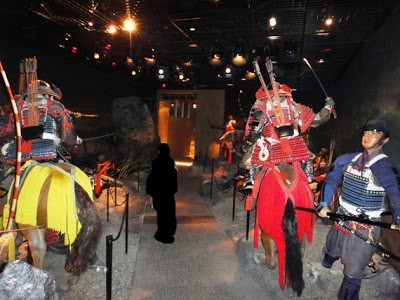
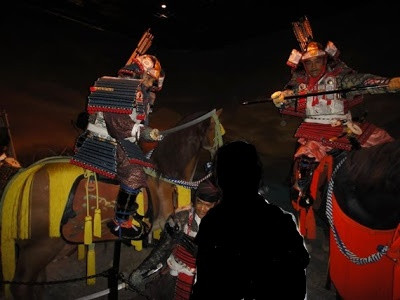
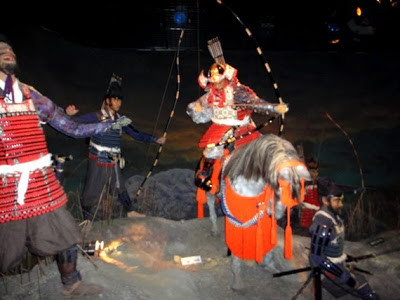
Scene 1: Zen-kunen-no-eki (9 Years War)
In 1051, Yoritoki Abe and Yoriyoshi Minamoto fought Zen-kunen-no-eki (9 Years War). Yoritoki Abe was governing Okumutsu-gun (present day Iwate prefecture) and Yoriyoshi Minamoto was the shogun. The war was the result of a clash between Abe, who was expanding his territory across the Koromogawa River, and Minamoto who was trying to prevent him from doing so. The war ended after 9 years because Takenori Kiyohara, head of a powerful family in Dewa (present day Akita prefecture), entered the war allied with Minamoto clan. This caused the fall of Abe clan.
Scene 2: Going to war
In 1056, in the middle of the 9 Years War, Kiyohira Fujiwara was born. His father was Tsunekiyo Fujiwara, from the powerful Watari family (present day Watari area in Miyagi prefecture). His mother was the daughter of Yoritoki Abe. Tsunekiyo Fujiwara was with Yoriyoshi Minamoto at the beginning of the war, which meant that he was fighting against his uncle, Yoritoki Abe. However, during the war, Tsunekiyo betrayed Yoriyoshi Minamoto and joined his uncle. As a result Yoriyoshi Minamoto harbored a grudge against Tsunekiyo. The scene shows Kiyohira’s mother sending her husband off to war.
Scene 3: Beheading
By 1062, Abe clan had been totally eliminated in Kuriyagawa-no-ki (present day northern part of Morioka). This ended the 9 Years War. Because Tsunekiyo betrayed Yoriyoshi Minamoto, he was particularly abused. He was beheaded with a dull sword thereby giving him torturous pain.
Scene 4: Mother’s remarriage
Kiyohira Fujiwara was a member of Abe clan and was to have been killed. However, his mother remarried Takesada Kiyohara, the heir of Takenori Kiyohara, who was on the Minamoto side. Kiyohira Fujiwara was supposed to be around 7 years old at that time. He was allowed to survive but he grew up under Kiyohara, an enemy of his father.
Scene 5: Kiyohira childhood
For their significant achievement in the 9 Years War, Kiyohara clan was appointed to govern the area. In time, Kiyohara clan acquired Mutsu area in addition to Dewa area. As a result, their power grew extensively. Young Kiyohira Fujiwara grew up in a rather complex family environment. His brothers each had a different father and mother.
Scene 6: Go-sannen-no-eki (3 Years War)
After the 9 Years War, Kiyohara clan continued in succession, first Takenori, followed by Takesada, and then Sanehira. During Kiyohara clan’s period of government, quarrels and conflicts arose within the family that caused criticism of the clan. Hidetake Kibiko, the clan’s elder leader, attended the wedding of Narihira, the adopted son of Sanehira. However, Sanehira ignored Hidetake and played the game Go with monk Nara. Hidetake became angry, turned over the tray of gold dust he had brought as a wedding present and went home. With this incident, criticism of the clan intensified and an internal 3 Year War began.
Next, we saw a few war scenes where no description was given but was related to the 3 Years War.
Scene 7: Kiyohira assassination attempt
In the 3 Years War, the governor of Mutsu, Yoshiie Minamoto, joined Sanehira. As a result Kiyohira and Iehira families surrendered. At the same time Sanehira died suddenly and the war ceased briefly. However, Iehira was not content with the division of territory following the war and he attempted to assassinate Kiyohira. The assassination attempt failed and the war began again. This scene depicts Kiyohira barely escaping assassination.
Scene 8: Winning the 3 Years War
With Yoshiie, the governor, Kiyohira raised an army to attack Iehira. In 1087, the army of Kiyohira defeated the enemy in a clash near a lake in Kanezawa-no-ki (present day Hiraga area in Akita prefecture), occupied the area, and killed Iehira, thus ending the 3 Years War.
Scene 9: Celebration
Yoshiie won the 3 Year War. However, since the Imperial Court of Kyoto considered this war as an internal conflict of Kiyohara clan, the Court not only did not award Yoshiie but discharged him from his duties as governor of Mutsu area. Kiyohira held a banquet for Yoshiie before his return to Kyoto, honoring him with gold, silk, a horse, a hawk’s feather, fur, and many other local products. From that time on, in Kyoto, Yoshiie was a supporter and protector of Kiyohira and became an important link between Kyoto and Mutsu area.
Scene 10: Hiraizumi – construction of the city
In time, Kiyohira left his castle in Toyoda-no-tachi and moved south to Hiraizumi where he started to build a new city. Hiraizumi is an important location because it is south of Koromonoseki. Three generations of Fujiwara clan, namely, Kiyohira, Motohira, and Hidehira, were based in Hiraizumi. Fujiwara clan built several temples like Chusonji, Motsuji, and Muryokoin to console the spirits of the war-dead.
Scenes 11 to 16 were the Golden Temple Konjikido, a residence Hiraizumi-no-tachi, Approach to Hiraizumi on a memorial service day, Buddhist prayer ceremony (Rakkei Hoyo) in Chusonji Temple, Motsuji Temple, and Bustling Town, respectively. All these scenes depict the prosperity and peacefulness of Hiraizumi.
Scene 17: Offering horse
After the 3 Years War, Kiyohira acquired a large and fertile area of land. In 1091, Kiyohira gave Morozane Fujiwara, the Emperor’s Chief Executor, two horses, local products, and land. By doing so, Kiyohira attempted to strengthen the link between them and thereby secured his political strength in Oshu area. At the same time, Kyoto culture became more strongly established in Hiraizumi. His successors, Motohira and Hidehira, also followed this political strategy. This scene depicts Motohira Fujiwara representing the second generation of Fujiwara clan.
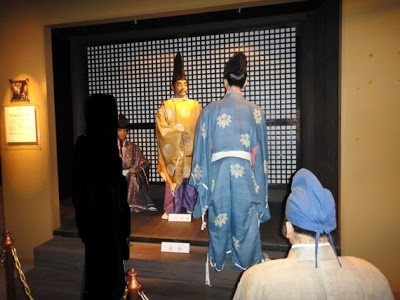

Scene 18: Yoshitsune entering Hiraizumi
Hidehira, the third generation Oshu-Fujiwara, was appointed governor of the area in 1170 and governor of Mutsu in 1181. Hidehira became the most powerful man in Mutsu and was known as the ‘King’ of northern Japan. At the same time, Yoshitsune Minamoto came to Hiraizumi, counting on Hidehira’s help. Yoshitsune was accompanied by a gold trader named Kaneuri Kichiji. Yoshitsune was a son of Yoshitomo Minamoto who was defeated by Kiyomori Taira in Heiji Rebellion. The scene depicts Hidehira welcoming Yoshitsune in front of the mansion Kyara-no-gosho.
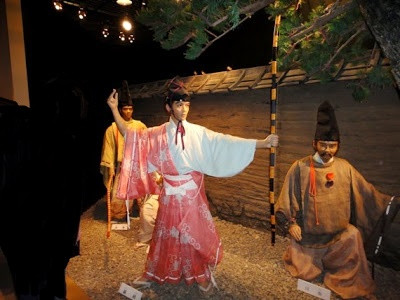

Scene 19: Yoshitsune in his youth
Yoshitsune lived in Hiraizumi when he was between 16 to 21 years of age under the protection of Hidehira. Yoshitsune practiced military arts with Hidehira’s sons (Kunihira, Yasuhira, and Tadahira), determined that someday he would defeat Heike (Taira) clan and re-establish Genji clan.
Scene 20: Yoshitsune going to war
In 1180, Yoshitsune heard that his brother, Yoritomo, raised an army to defeat Heike clan, and so decided to join him. Hidehira was against Yoshitsune’s participation in his brother’s attempt and tried to convince him otherwise. However, Hidehira learned that Yoshitsune was strongly determined and gave in. The scene shows Yoshitsune going to war.
We somehow missed the scene 21, which was an image of a famous poet Saigyo Hoshi.
Scene 22: Amitabha
Hidehira had built a temple named Muryokoin. This is one of the major temples, along with Chusonji and Motsuji, representing Hiraizumi culture. This temple copied the Ho-o-do Pavilion of Uji-Byodoin Temple in Kyoto. The temple is dedicated to Amitabha. The scene here depicts a 2.4 meters high seated statue of Amitabha.
Scene 23: Battle of Dan-no-ura
In spite of the peace in Oshu, in the western part of Japan, Minamoto and Taira clans were still fighting. Yoshitsune was a skilful master of surprise attacks during battles. In one battle, Yoshitsune chased the Heike clan to Ichi-no-Tani (present day Kobe) and then to Yashima (present day Takamatsu in Kagawa prefecture) and on to Dan-no-ura (present day Shimonoseki in Yamaguchi prefecture). Yoshitsune was also known as a superb fighter. He was particularly well known for his feats in the battle of Dan-no-ura, where he jumped from boat to boat killing many enemy soldiers.
Scene 24: Ataka-no-seki checkpoint
Yoshitsune lead the Minamoto-Heike war to victory for Genji clan. After his triumphant return to Kyoto, problems developed between Yoshitsune and his brother Yoritomo. Finally, Yoritomo received an order from the Imperial Court to dispel Yoshitsune. Yoritomo raised an army against Yoshitsune. So Yoshitsune fled to Hiraizumi, counting on Hidehira’s help. Hardships faced by Yoshitsune during the trip have been depicted in various plays and novels. Perhaps the most famous ones are the Noh play ‘Ataka’ and Kabuki play ‘Kanjincho’. In these plays, the famous incident of Yoshitsune and his retainer Benkei at Ataka-no-seki checkpoint is depicted. Ataka-no-seki is present day Komatsu in Ishikawa prefecture. Disguised as Buddhist monks, Yoshitsune and Benkei tried to cross the checkpoint. Togashi, the gateman at the checkpoint, saw through their disguises but was touched by Benkei’s courage and loyalty towards Yoshitsune. So in the end Togashi allowed them go instead of turning them in to Yoritomo.
Scene 25: Reunion
Between the end of 1186 and the spring of 1187, Yoshitsune finally arrived in Hiraizumi after escaping Yoritomo’s chase and many hardships. Yoshitsune was warmly welcomed by Hidehira. Protecting Yoshitsune, however, meant that Hidehira had to turn against Yoritomo.
Scene 26: Hidehira succumbs to illness
In 1187, Hidehira died of an illness. He was thought to be 66 years old at the time of his death. Hidehira’s death was a tremendous shock to Yoshitsune. Fujiwara clan was powerful because of Hidehira. His death increased the tension between Yoritomo and Fujiwara clan.
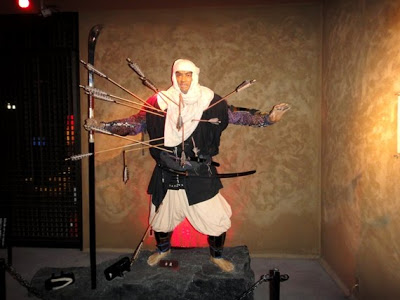

Scene 27: Last stand of Benkei
Yoritomo repeatedly demanded that Yasuhira, Hidehira’s successor, kill Yoshitsune. Two groups were formed in Fujiwara clan due to internal disagreements. One group followed Hidehira’s legacy to support Yoshitsune and the other group followed Yoritomo’s orders. In 1189, Yasuhira attacked the Yoshitsune group with a surprise attack on Koromogawa house where Yoshitsune resided. Yoshitsune killed himself along with his wife and children in spite of Benkei’s efforts to save them from the enemy. Benkei fought on at the bridge in front of the main gate of the house. Long after the battle was over, Yasuhira’s soldiers noticed that the arrow-riddled wound-covered Benkei was still standing. So when the soldiers crossed the bridge to look more closely, Benkei fell to the ground, having been dead in a standing position for some time before that. This is known as the ‘standing death of Benkei’. The scene depicts arrow-riddled mortally wounded Benkei.
Scene 28: Fall of Fujiwara clan in Oshu
Yasuhira gave in to pressure from Yoritomo, betrayed his father’s will, and drove Yoshitsune to suicide. However, Yoritomo accused Yasuhira of giving refuge to Yoshitsune. Yoritomo sent troops to Hiraizumi from Kamakura and attacked Yasuhira. In 1189, Yasuhira burned the Hiraizumi House by himself and escaped to the north. However, he was killed by Jiro Kawada, his retainer. Following this incident, Fujiwara clan, which had governed Oshu for 100 years, ceased to exist.
Scene 29: Hiraizumi burning
When Yoritomo’s troops from Kamakura entered Hiraizumi, the whole town was burning. Much treasure was found in the remaining warehouses, surprising the samurai from Kamakura. The scenery in Hiraizumi produced a lasting impression on Yoritomo. When he built temples in Kamakura, he modeled them after Hiraizumi. The scene depicts Yoritomo watching Hiraizumi burning.
Scene 30: Warrior’s dream
500 years after the fall of Fujiwara clan, Hiraizumi was governed by Date clan. During this period, Haiku poet Matsuo Basho visited Hiraizumi and wrote a verse lamenting the fate of Yoshitsune.
The summer grass
It’s all that’s left
Of ancient warrior’s dream

